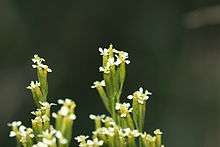Tagetes minuta
| Tagetes minuta | |
|---|---|
 | |
| Scientific classification | |
| Kingdom: | Plantae |
| (unranked): | Angiosperms |
| (unranked): | Eudicots |
| (unranked): | Asterids |
| Order: | Asterales |
| Family: | Asteraceae |
| Tribe: | Tageteae |
| Genus: | Tagetes |
| Species: | T. minuta |
| Binomial name | |
| Tagetes minuta L. | |
| Synonyms[1] | |
| |
Tagetes minuta has numerous local names that vary by region, most commonly found in the literature as; chinchilla, chiquilla, chilca, zuico, suico, or the Spanish term anisillo.[2] Other names include muster John Henry,[3] southern marigold,[4] stinking roger[5] wild marigold,[6] or black mint, is a tall upright marigold plant from the genus Tagetes, with small flowers, native to the southern half of South America.[6] Since Spanish colonization, it has been introduced around the world, and has become naturalized in Europe, Asia, Australasia, North America, and Africa.[6]


It is used as a culinary herb in Peru, Ecuador, and parts of Chile and Bolivia. It is called by the Quechua terms wakatay in Peru[7] or wakataya in Bolivia.[8] It is commonly sold in Latin grocery stores in a bottled, paste format as black mint paste.
Description
This species of marigold may grow to become from 0.6–2 meters tall.[2]
Uses
The New World peoples have been using Tagetes minuta as a flavorful beverage, a medicinal tea, and a condiment since pre-contact times.[2]
The leaves when dried may be used as a seasoning.
Wakatay paste is used to make the popular Peruvian potato dish called ocopa''.
For some time people have used it as a flavorful herbal tea for medical benefits such as a remedy for the colds, respiratory inflammations, or stomach problems.
It can be used to produce an organic dye (known as Tamidye or TAMI dye) which was developed at Moi University in Kenya under the direction of R. K. Mibey.[9]
Plants are harvested and "marigold oil" extracted for use in the perfume, tobacco, and soft drink industry.[2]
Toxicity
The oils contained in the oil glands that are found throughout the above ground portions of the plant may cause irritation to the skin and in some cases are said to cause photodermatitis.[2]
References
| Wikimedia Commons has media related to Tagetes minuta. |
| Wikispecies has information related to: Tagetes minuta |
- ↑ "The Plant List".
- 1 2 3 4 5 Soule, J.A. 1993. Tagetes minuta: A potential new herb from South America. p. 649-654. In: J. Janick and J.E. Simon (eds.), New crops. Wiley, New York.
- ↑ "Tagetes". Natural Resources Conservation Service PLANTS Database. USDA. Retrieved 7 December 2015.
- ↑ "BSBI List 2007". Botanical Society of Britain and Ireland. Archived from the original (xls) on 2015-02-25. Retrieved 2014-10-17.
- ↑ California Dept. of Food and Agriculture data sheet: Tagetes minuta
- 1 2 3 "USDA GRIN Taxonomy".
- ↑ Diccionario Quechua - Español - Quechua, Academía Mayor de la Lengua Quechua, Gobierno Regional Cusco, Cusco 2005 (Quechua-Spanish dictionary)
- ↑ Teofilo Laime Ajacopa, Diccionario Bilingüe Iskay simipi yuyayk'ancha, La Paz, 2007 (Quechua-Spanish dictionary)
- ↑ Too, Titus (February 1, 2012). "Varsity breaks ground with dye made from weed". The Standard. Retrieved 18 August 2012.
Sources and external links
- Makang' a, Omache Benard (2013-03-20). "Composition and repellency of essential oils of Tagetes minuta from different zones in Kenya against Brown Ear Tick (Rhipicephalus appendiculatus)" (PDF). Kenyatta University.